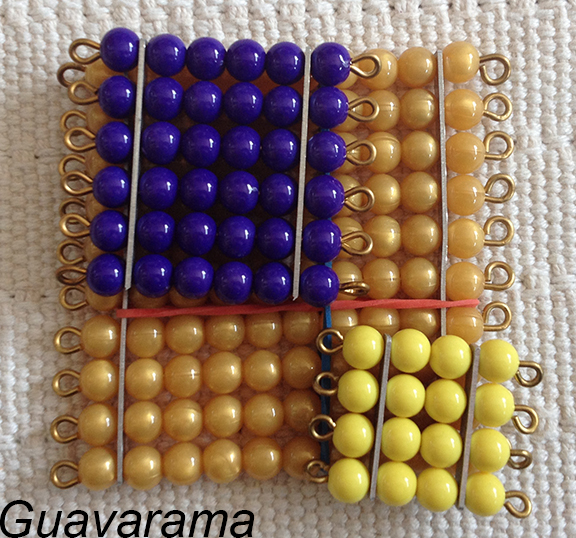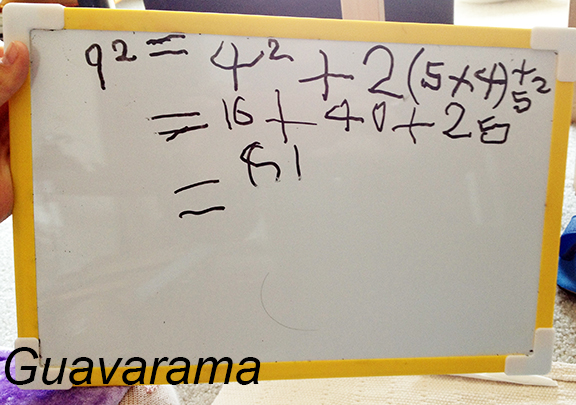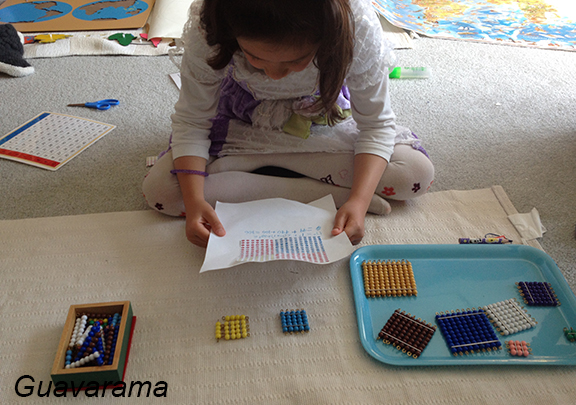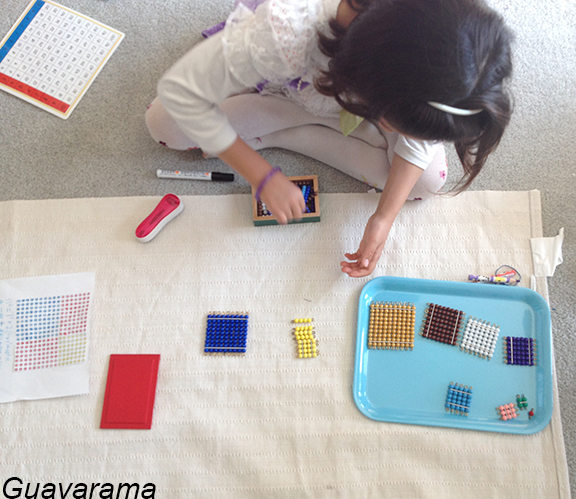Age: 7.5
Presentation: Transformation of a Square, Passing from One Square to Another, Concept and Notation of Square Roots, Extracting a square root for numbers less than 225.
After our introduction presentation about a month ago to squaring and cubing, I gave some more to Thumper on Monday, as part of my studying for my oral exam. Maybe a terrible reason to give presentations, but, I’m discovering, we’re actually at exactly the right age for learning how to make squares. She really loved the material and learning. There were many, “aha! I know why” moments. I wish everyone could learn their squares this early!

Transformation of a Square is the first presentation. Here is where you hold up a 10 square, and using rubber hands, divide it up so that it has 2 perfect squares and 2 rectangles. For our example, we divided it into (4+6)2. Then you talk about what you just did. This 102 got split up into a 42 and a 62 and 2(4×6) rectangles. All this gives you: 102 = 42 + 2(4×6) + 62 .

Thumper tried it herself with other squares. She has not quite figure out that the equation uses only 2 numbers. So you can predict what the equation is even without looking at the concrete square. But I was so good, I did not tell her. Of course, being an elementary child, she wanted to try this “division on a 1-square and 2-square, which doesn’t play as nicely. After playing with the squares, we wrote down the equation on our whiteboard and made some mental math calculations to verify that it all adds up. The next exercise in the presentation had her drawing her own squares. She drew a 17×17 square. But was unable to write out the equation correctly.

We then moved on to Passing from One Square to Another, which she immediately wanted to do when she was playing with the squares during the first presentation. Because the first thing she did when trying to see what squares fit into the big 102 was to try to use the other bead squares to reconstruct. In this presentation, you first try to go from a 42 to a 52 , write the equation out. Then you go from 42 to a 92 . Because she had learned how to transform a square, she knew how to write the equation out. 92 = 42 + 2(4+5) + 52.

Technically I really shouldn’t have continued on with square root. But I wanted to practice. So I just gave her a short intro with the Concept and Notation of Square Roots and Extracting a square root for numbers less than 225, since those just use her knowledge of what a square is.
In these two presentations, you basically learn what a square root is, and then you try to figure out the square root of a number by using pegs. See how many perfect squares you can build before you run out of pegs. For example, we started with trying to find the square root of 14. You do it by first building 1 square, then building it into a 2 square, then 3 square. You have to stop after 3 square, with 5 as a remainder.
I stopped after that because she needs more practice, especially with her not being too familiar with multiplication yet. And the next steps starts getting into algebraic expressions, using a and b instead of numbers. I think that’s a bit too early for her.
But isn’t the material and concept fun and easy to learn? I never thought about squares and square roots this way, but it makes so much sense when you are playing with concrete materials.
I find the children get math in Chinese because of the way we count. BUT, they get confused by the place values because it’s not the same as in English. So we will continue to teach math in Chinese, with English thrown in when I introduce nomenclature.
Chinese Nomenclature
Here are some words you will need to know to teach squaring and cubing in Chinese.
- square – 平方
- cube – 立方
- square root – 平方根
- cube root – 立方根
- radical – 根號
- radicand – 開方數